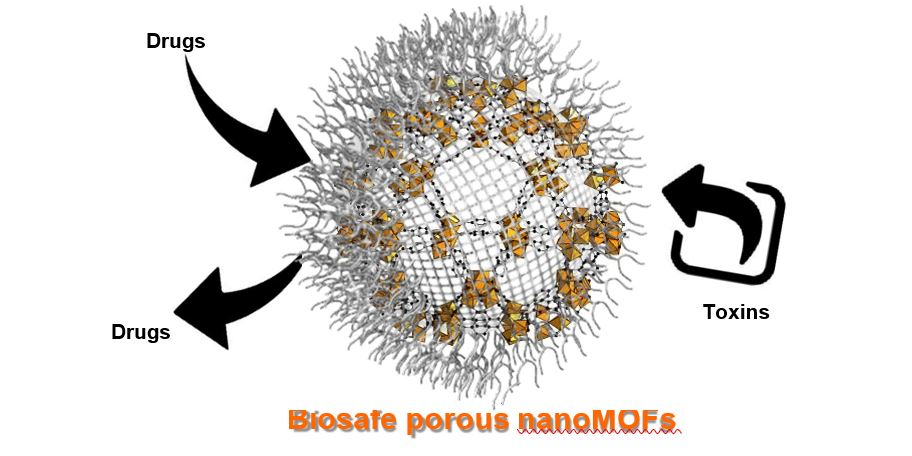Video Article Open Access
Metal Organic Frameworks: From Drug Vectorization to Decontamination
Patricia Horcajada*, Sara Rojas, Tania Hidalgo, Ana Arenas-Vivo
Advanced Porous Materials, IMDEA Energy, Móstoles, Spain
Vid. Proc. Adv. Mater., Volume 2, Article ID 2103165 (2021)
DOI: 10.5185/vpoam.2021.03165
Publication Date (Web): 03 Aug 2021
Copyright © IAAM
Graphical Abstract

Abstract
The involvement of Metal-Organic Frameworks (MOFs) in biomedical applications is currently one of the hot topics in the emerging field of hybrid porous solids. In particular, nanometric iron carboxylate MOFs (nanoMOFs) have recently attracted a great deal of attention owing to their large porosity and versatile composition, enabling to entrap remarkable loadings of a wide variety of challenging molecules, including drugs and toxins [1]. However, for the practical use of MOF nanocarriers, it is necessary to investigate their safety, biodistribution and efficiency. Here, the administration of MOFs by different administration routes (e.g., intravenous, oral, cutaneous, pulmonary) will be presented [2].
Further, the therapeutic misadventures, illicit drug ingestion or attempted suicide by using of drug overdoses is a major worldwide public health problem. Unfortunately, current treatments are accused of being ineffective and even of causing unnecessary complications, inducing severe adverse effects. In this context, MOFs has also recently demonstrated to be promising safe and efficient oral detoxification agents [3]. MOFs can not only acts as contaminant adsorbents in the body, but also in polluted water, selectively removing contaminants (e.g. drugs) by adsorption and catalytic degradation, improving the performance of the current inefficient materials [4].
Keywords
MOFs; drug delivery; administration; detoxification.
Acknowledgement
The authors are grateful for the generous support from Raphuel project (ENE2016-79608-C2-1-R, MINECO-AEI/FEDER, UE) and Fundación Ramón Areces programme (H+ MOFs project). PH acknowledges Ramón y Cajal funding programme (RYC-2014-15039; Ministerio de Ciencia, Investigación y Universidades) and SR and TH thanks to the Talento Junior fellow from Comunidad de Madrid.
References
- S. Rojas et al., Coord. Chem. Rev., 2019, 388, 202.
- E. Bellido et al., Adv. Health. Mater., 2015, 4, 1246; A. Garcia-Márquez et al., J. Mater. Chem. B, 2016, 4, 7031; T. Hidalgo et al., Sci. Rep., 2017, 7, 43099; T. Simon-Yarza et al., Angew. Chem. Int. Ed., 2017, 56(49), 15565; C. Carrillo et al, Angew. Chem. Int. Ed. 2019, 58(21), 7078; C. Fernandez-Paz et al. ACS App. Mater. Inter. 2020, 12(23), 25676.
- S. Rojas et al., J. Am. Chem. Soc. 2018, 140, 9581; ACS Appl. Mater. Interf. 2019, 11, 22188.
- S. Rojas, P. Horcajada, Chem. Rev. 2020, 120, 16, 8378.
Biography
Patricia Horcajada, With an unconventional and multidisciplinary scientific background (Pharmacy BCs, 2001 and Material Science Ph.D, 2005; University Complutense of Madrid, Spain), her pioneered PhD work was focused on porous materials for bone replacement and drug release. She then joined the Institut Lavoisier-France, as CNRS researcher, initiating a totally new field, the biomedical application of MOFs. Since 2016, Dr. Horcajada (h=56, >17500 citations, 140 publications and 9 patents) is Senior Researcher and the Head of the Advanced Porous Materials unit in IMDEA Energy (Spain). Her research activity is focused on the development of new porous materials with advanced functionalities, from their synthesis design and specific shaping/formulation to their applications in diverse industrial and societal strategic fields, including energy, environment and health.
Video Proceedings of Advanced Materials

Upcoming Congress



